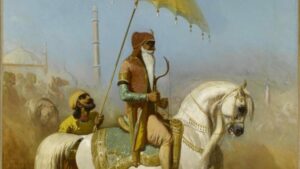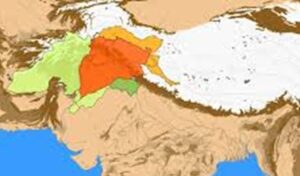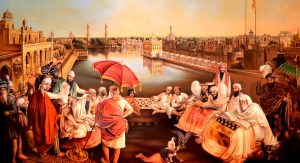Col. Alok Mathur, SM (Military Veteran)

On 27 June 1839, 185 years ago, Maharaja Ranjit Singh, the legendary Emperor of Punjab, who ruled northern and western India from 1801 to 1839, died at Lahore after a long illness. This article is a tribute to the great Maharaja, also called Sher-e-Punjab and Sher-e-Lahore, who was a true warrior, king and founder of the Sikh Empire. The Mughals, Afghans and British were equally wary of his visionary leadership, power, boldness, and bravery.
Childhood Cut Short
Maharaja Ranjit Singh, was born on 13 November, 1780, in the Sandhawalia Sikh family that held suzerainty of the Sukerchakia Misl. His father, Sardar Maha Singh, was chieftain of the Sukerchakia Misl; his mother, Bibi Raj Kaur, was the daughter of Raja Gajpat Singh of Jind State.
The Misls of Punjab were twelve independent military confederacies that emerged in 18th-century Punjab. They were autonomous principalities ruling over vast tracts of land united under the Dal Khalsa banner. In times of military crisis, they joined hands to fight for Punjab. The Sukerchakia Misl held suzerainty over the areas of Gujranwala, Punjab, now in Pakistan.
Ranjit Singh’s childhood name was Buddh Singh. He contacted small pox as a child which resulted in the loss of vision in his left eye. It also left pock-marks on his face. He was short in stature but very agile and brave. He never went to school but learnt Gurmukhhi and recitation of Gurbani. He mastered musketry, horse riding, archery, fencing and martial arts in early age and was a particularly good horseman. He fought along his father against the Chattha dynasty at the age of 10. His father was so impressed with his bravery in the battle that he renamed him Ranjit Singh (victorious Lion).
Ranjit Singh was only 12 years old when his father died. His mother Bibi Raj Kaur managed the Sukerchakia Misl along with a loyal chieftain, Lakhpat Rai. There were several attempts made by Hashmat Khan and others to assassinate him but he survived. His mother died when he was only 18 years old and his mentor Lakhpat Rai was also killed. Ranjit Singh them took charge of his Misl.
The Build-up of the Empire
After the death of Aurangzeb in 1707, the Mughal empire had started crumbling and gradually it lost all control in Punjab. The space was filled by the Khalsa Army after a sustained struggle with both the Mughals and the Afghans that lasted for more than a century. Meanwhile, colonial traders from Europe have also started establishing bases, but Punjab was affected by this evil force much later since the conspiracy took time to move from the South-East of the subcontinent to the west and finally towards the North.
By 1750, there were 14 Misls operating in Punjab. Twelve of these had Sikh suzerainty; the Kasur Misl had a Muslim head and one Misl also had a British head. By 1800, five major Sikh Misls (Sukerchakia, Ahulhuwalia, Nakkai, Kanhaiya and Bangis) came under Ranjit Singh through a clever weave of marriage diplomacy and use of military power.
Ranjit Singh’s first wife was Mehtab Kaur, the only daughter of Gurbaksh Singh Kanhaiya. The marriage took place in 1789. Ranjit Singh’s mother-in-law, Sada Kaur, advised and motivated him in his pursuit of total suzerainty over the Sikh lands.
In 1797, he further strengthened his hold by marrying Dalat Kaur, the daughter of Sardar Ran Singh Nakai. She was a favorite of the Maharaja and wielded a lot of power in his court. His son from Dalat Kaur, Kharak Singh, was the first born of the family and as such the crown prince. He ultimately succeeded the Maharaja and became the ruler of the Sikh Empire. Ranjit later married Roop Kaur, Gulab Kaur, Saman Kaur and Laxmi Kaur. He married Jind Kaur in 1838, who was mother of Duleep Singh, the last Maharaja of the Sikh Empire.
Ranjit Singh modernised his Army and built it into one of the strongest fighting machines of those times. It comprised all fighting arms including horse cavalry, infantry and artillery equipped with the best available weaponry including the biggest cannons of those times. He paid his soldiers well and did not differentiate on the basis of caste and creed. Hence he had French, Italian, Russians, Persians as soldiers in his Army, some of whom rose to the rank of generals. Of course, a major portion of the force comprised Sikhs and Hindus including Rajputs, Dogras, Brahmins and other Indian castes. His army drew strength from his secular thought process and was commanded by seasoned Generals like Hari Singh Nalwa, Zorawar Singh, Veer Singh Dhillon and Dewan Mokam Chand. He however did not trust the British.

The Sikh Empire of Maharaja Ranjit Singh
The first major victory of Ranjit Singh was in 1797 when, in the Battle of Amritsar, he defeated the 12,000 strong Army of the Afghan king, Zaman Shah, which was led by Ahmad alias Shahanchi Khan. He was 17 years of age at that time. In 1798, he encircled Zaman Shah’s Army in Lahore and cut off its supplies and forced the Afghan king to retreat. Emboldened by his victories he pressurized the weakened Bhangi Misl of Lahore diplomatically and militarily and captured the city in in 1799 with his 25,000 strong Khalsa Army. In 1800, the ruler of Jammu also ceded to his empire.
Ranjit Singh was coronated in 1801 as Maharaja of Punjab. He established his capital at Lahore. The investiture ceremony was performed by Baba Sahib Singh – a descendant of Guru Nanak. His rule was called Sakar-e-Khalsa and court was known as Darbar Khalsa. He struck new coins called Nanak Shahi in name of Guru Nanak. In 1802, he took over Amritsar and paid homage at Harminder Sahib. He donated gold to gold-plate the outer façade; in keeping with his secular vision he also gave gold to the Jwalamukhi Mata Shaktipeeth in Kangra and to the Kashi Viswanath temple in Varanasi.
The Khalsa Army captured Kasur in 1807. He captured Multan in 1818 and Sindh in 1821. He defeated Mohmmad Azim Khan in 1834 and recaptured Peshawar. He defeated Afghans in 1813, 1823, 1834 and 1835, the Battle of Jamrud in 1835 was his last battle between Afghans and Sikhs, in which the Sikhs emerged victorious.
The Sikh Empire of Maharaja Ranjit Singh included all lands north of Sutlej, and south high valleys of Himalayas. The major towns under the empire included Srinagar, Attock, Peshawer, Bannu, Rawalpindi, Jammu, Gujrat. Sialkot, Kangra, Amritsar, Lahore, and Multan.
Maharaja Ranjit Singh managed the growing influence of the British with exemplary diplomatic finesse. He and the British were well aware of their relative power and did not wish to engage in conflict. This led to the inking of the Treaty of Amritsar, on April 25, 1809, between the British East India Company and the Sikh Empire which established the Sutlej River as the boundary between their respective territories. He signed a treaty with East India Company in 1838 and restored Afghan rule in Kabul. The Khalsa Army participated in a joint Victory Parade along with British in Kabul.
The Persona of Maharaja Ranjit Singh
Despite being blind in one eye and injured in one arm, Maharaja Ranjit Singh integrated the highly volatile and disparate Sikh Misls and built one of the most glorious Empire in history in a short period of time. He introduced various reforms and welfare measures for public. Even though he remained unlettered, Punjab became the most literate state of the sub-continent under his rule. His finance minister was a Hindu Brahmin, his Prime Minister was a Dogra, his foreign minister a Muslim. He was so sensitive to the religious beliefs of his subjects that he banned cow-slaughter in this empire.
He developed infrastructure and build highways and canals. He reduced the taxes on traders and the poor people. His legacy boosted the Sikh cultural values and artistic renaissance. He undertook massive renovation of old Gurudwaras and shrines which included the rebuilding and beautification of Harminder Sahib in Amritsar, Takht Patna Sahib in Bihar, Hazur Sahib at Nanded, Maharashtra and various other Gurudwaras.

Maharaja Ranjit Singh at Harmandir Sahib
Apart from being a great warrior and an equally able and wise ruler the Maharaja was, most importantly, a great human being. During his reign Punjab became rich and prosperous. He had retrieved the Kohinoor diamond from Shuja Shah Durrani of Afghanistan and possessed it till his death. He handed it over to Jagan Nath Temple Odisha in 1839 before his death. Later. Maharaja Duleep Singh handed it over to Queen Victoria.
Maharaja Ranjit Singh is the only king in history of world to have conquered and tamed Afghans, which even modern militaries of Russia and USA could not achieve. A great warrior, able and wise ruler, great human being and loved by his people.
Maharaja Ranjit Singh died in his sleep on 27 June 1839 at the age of 58 years. He offered prayers to Guru Granth Sahib and Lord Vishnu on his last day. He will be remembered for his conquests and for establishing the largest Sikh Empire from Kabul River to Sutlej River across Khyber Pass in the Hindukush mountains. His empire extended in modern day Punjab, Jammu, Kashmir, Ladakh, Himachal and even Tibet.
The Break-up of the Sikh Empire
The British conquered many states in India and often reinstated the rulers to continue with the administration after paying due tribute to the British Empire. In the case of Punjab, they dispossessed the ruler Maharaja Duleep Singh and did not allow him to get back to his people. This was because of their mortal fear of Punjab and its people who, they felt, could overthrow them at any time if they got the leadership of the family of their beloved leader, Maharaja Ranjit Singh. On the other hand, they allowed many princes in the Punjab to flourish since they were pliant and loyal to the British crown.
The British also realised that keeping Punjab, especially Sikhs on their side was imperative to continue their hold on the Indian land mass. They, therefore, treated Sikhs with utmost respect and gave preferential recruitment to Sikh youth in the British Indian army. This policy helped them control the Afghans and the Russians and also paid invaluable dividends in World War I and World War II.
Finally, the British realized that Punjab and the Sikhs were the only race that would put paid to their mischievous plan to control the sub-continent by creating a plaint state in the form of Pakistan. They, therefore, gave away Lahore, the enduring legacy of Maharaja Ranjit Singh and other significant Sikh institutions like Gurdwara Kartarpur Sahib and Gurdwara Nankana Sahib to the enemy nation Pakistan.
It is unfortunate that the Indian leadership of the time did not see through the evil plan and machinations of the British and agreed to weaken the very region that would have been its enduring strength. Sadly, the lack of understanding of Punjab has since of independence.
Conclusion
Humble tributes to Maharaja Ranjit Singh on his 185th Death Anniversary. He was not only Sher-e-Punjab but indeed Sher-e-Bharat. His legacy needs to form an integral part of Indian history and one that pursued glory instead of conspiracy and defeat. He has to be placed as a motivating icon of the future generation on nationalist Indians.
test